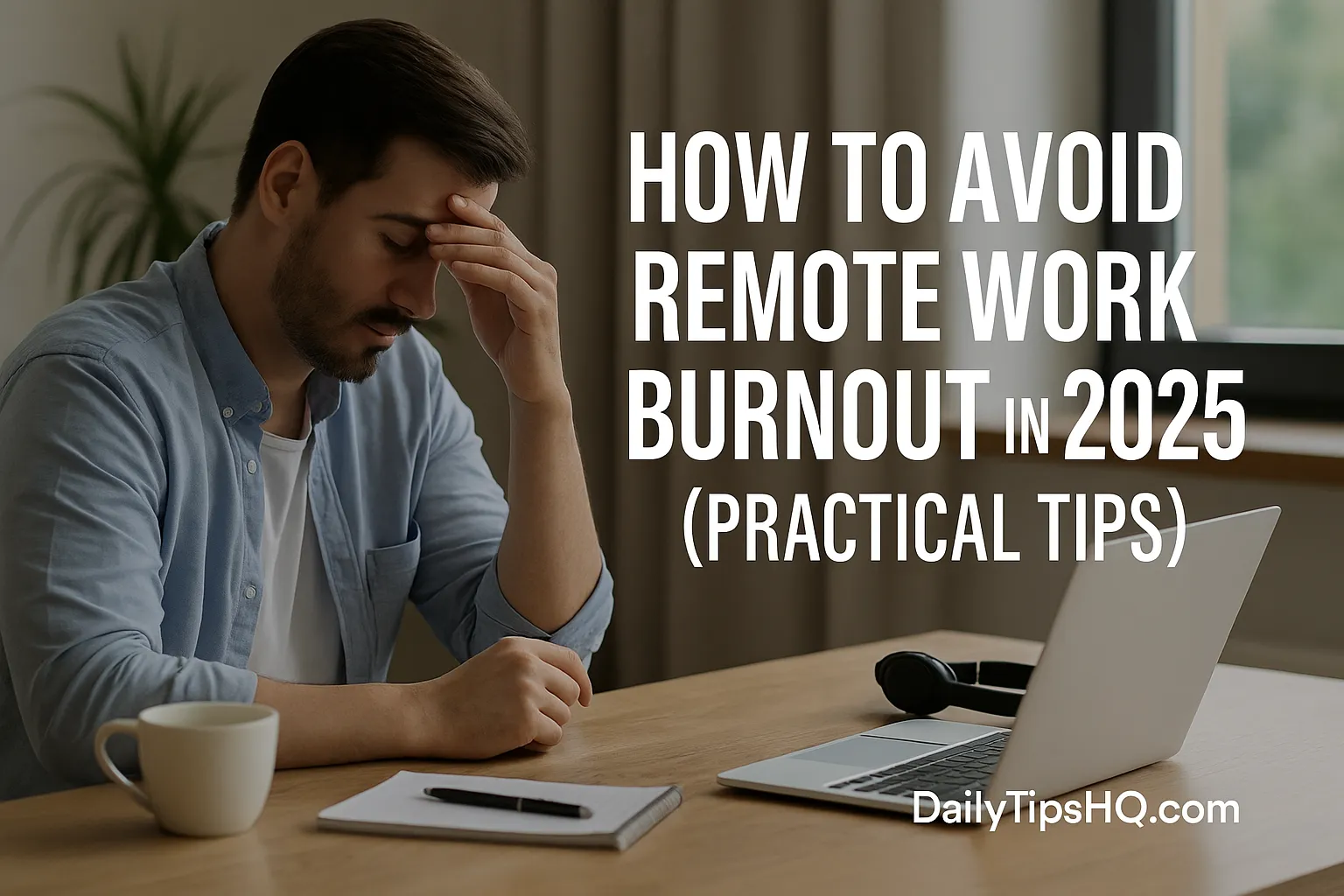How to Avoid Remote Work Burnout in 2025 (Practical Tips)
Remote work offers flexibility, freedom, and convenience. But it also comes with a hidden cost: burnout. As remote and hybrid work become the standard in 2025, many professionals face exhaustion, stress, and declining productivity. Burnout doesn’t just impact your career—it affects mental health, physical well-being, and personal relationships. The good news? With the right strategies, remote work can be sustainable and fulfilling. In this guide, we’ll explore how to recognize, prevent, and recover from remote work burnout.
What Is Remote Work Burnout?
Burnout is more than feeling tired—it’s a state of emotional, mental, and physical exhaustion caused by prolonged stress. Remote work burnout happens when the challenges of working from home—blurred boundaries, isolation, and overwork—push people beyond their limits.
Key symptoms of remote work burnout:
- Constant fatigue, even after sleep.
- Decreased motivation and creativity.
- Cynicism or frustration toward work.
- Declining performance despite working longer hours.
- Physical problems such as headaches, back pain, or eye strain.
Left unaddressed, burnout can lead to long-term health issues, including anxiety, depression, and chronic illness. Recognizing it early is critical.
Why Remote Workers Are Vulnerable to Burnout
Remote work seems ideal—no commute, flexible hours, and more autonomy. Yet these very advantages also hide traps:
- Blurred boundaries: Without a commute or office separation, many work longer hours and struggle to “switch off.”
- Lack of social interaction: Remote workers often feel isolated, missing casual office connections.
- Always-online culture: Pressure to be available 24/7 creates constant stress.
- Work-life overlap: Caring for children or household tasks while working increases mental load.
Example: John, a remote engineer, realized he was working 12-hour days without breaks because his home office was just a few steps away. Within months, he felt exhausted and disconnected from friends and family.
Warning Signs to Watch For
Spotting burnout early makes it easier to prevent. Common red flags include:
- Trouble sleeping: Difficulty falling asleep or waking up exhausted.
- Loss of motivation: Struggling to start tasks you once enjoyed.
- Irritability: Becoming easily frustrated with colleagues or family.
- Procrastination: Avoiding tasks, even simple ones.
- Physical symptoms: Frequent headaches, eye strain, or chronic back pain from poor ergonomics.
If you notice multiple symptoms persisting for weeks, it’s time to take action.
Practical Strategies to Avoid Burnout
Preventing burnout requires deliberate actions. Here are strategies you can implement immediately:
Set Clear Work Hours & Stick to Them
Create a schedule and communicate it to your team. Stop work at a fixed time, just as you would in an office. Use digital calendar reminders or alarms to signal the end of the workday.
Take Real Breaks Away From Screens
Scrolling social media isn’t a break—it’s screen fatigue. Step outside, stretch, or make tea. Even 5 minutes of real rest refreshes your brain more than 20 minutes of mindless scrolling.
Prioritize Exercise and Movement
Sitting all day increases stress and harms health. Walk, stretch, or do short workouts. Apps like Seven or FitOn offer free 7-minute routines perfect for remote workers.
Separate Workspace and Personal Space
If possible, dedicate a room or corner for work. Avoid working from bed or sofa—your brain needs environmental cues to distinguish “work mode” from “rest mode.”
Practice Mindfulness and Relaxation
Simple practices like meditation, deep breathing, or journaling reduce stress. Apps like Headspace or Calm provide guided sessions. Even 5 minutes daily helps restore balance.
Long-Term Habits for Sustainable Remote Work
Short-term fixes help, but long-term habits ensure you thrive:
- Healthy routines: Start and end your day with rituals—morning stretches, evening walk, or journaling.
- Regular social connection: Schedule video chats with colleagues or friends. Human interaction combats isolation.
- Take vacations seriously: Remote workers often skip vacations, but downtime is vital for recovery. Even staycations reset your mind.
- Seek professional help if needed: If stress becomes overwhelming, therapy or counseling can provide support and strategies.
Tools That Can Help
Technology can assist in preventing burnout if used wisely:
- Time-tracking apps: RescueTime, Toggl, or Clockify reveal how you spend your hours.
- Break reminder apps: Stretchly or Pomofocus encourage regular pauses.
- Meditation & wellness apps: Calm, Headspace, or Insight Timer reduce stress.
- Focus tools: Forest or Freedom block distracting websites, keeping your mind on track.
Final Thoughts
Remote work burnout is real, but it’s not inevitable. With clear boundaries, intentional breaks, exercise, mindfulness, and supportive tools, you can enjoy the benefits of remote work without sacrificing health. Remember: productivity is not about working longer—it’s about working smarter and sustaining your energy long-term.
Pro Tip: Don’t wait until burnout hits. Start building protective habits today, even if you don’t feel exhausted yet. Prevention is easier than recovery.
FAQ
Q1: Is remote work burnout different from office burnout?
Yes. While both share symptoms, remote burnout is often caused by isolation, blurred boundaries, and constant digital communication rather than office politics or commutes.
Q2: How can I set boundaries when my boss expects me online?
Communicate availability clearly and set “office hours” in your calendar. Many managers respect boundaries when expectations are transparent.
Q3: Can exercise really reduce burnout?
Absolutely. Physical activity lowers stress hormones, boosts energy, and improves mood. Even short daily movement makes a difference.
Q4: What’s the best break schedule for remote workers?
The 50/10 rule works well: 50 minutes of focus followed by a 10-minute break. Alternatively, use the Pomodoro method (25/5 intervals).
Q5: How do I know if I’m already burned out?
Signs include chronic fatigue, loss of motivation, irritability, and declining performance. If these persist for weeks, you may be experiencing burnout.
Call to Action
👉 Protect your health and productivity. Choose one strategy from this guide—whether it’s setting work hours, moving more, or practicing mindfulness—and apply it today. Small steps prevent burnout and build a sustainable remote work lifestyle. For more strategies, check out our guides on work-life balance and time management.

